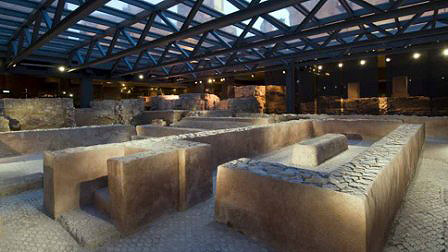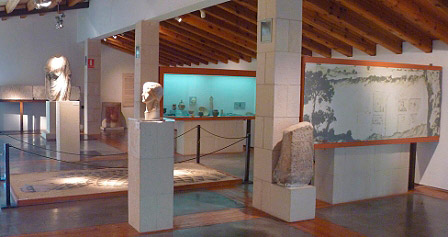November 19, 2014
Global Seminars & Invited Speaker Series
HERITAGE AND SPEECH. A FRAMEWORK DE REFERENCE LETTER
Communicating Heritage: between necessity and excesses
D. René Payo Hernanz
University of Burgos
Since the middle of the last century, a process of "democratization" of the enjoyment of patrimonial goods has taken place B . What until then had been limited to a few educated minorities and with economic possibilities, became a common internship of the "society of masses" thanks to two facts fundamentally: the consolidation and the growth of the "middle classes" with a certain economic level and the elevation of the cultural level of the population. All this fostered an activity subject , based on the approach and enjoyment of Heritage assets, which is included in the broader phenomenon of "Cultural Tourism".
Two parallel vectors that, sometimes converge, are developed around the phenomenon of "Cultural Tourism", linked to Heritage. Firstly, the awareness not only of the administrations but also of most of society as a whole that the knowledge of our heritage generates beneficial results on individuals and also tends to create collective feelings, for the most part, of a positive nature. Secondly, the undoubted economic value generated by many of these heritage resources, which undoubtedly facilitates the generation of sources of wealth and, in many cases, guarantees the sustainability of these assets.

Almoina Interpretation Center (Valencia)
All of the above requires the development of correct techniques of communication of the Heritage. We will not refer here to scholarly or academic programs of study on the same. These works, although they sometimes reach relatively wide audiences, must be considered as the starting point for the emergence of the correct strategies to connect these assets with the "mass society". Nor will we analyze the exciting world of heritage didactics in schools.
Our analysis will focus on two points. Firstly, the communication of Heritage before its visit or enjoyment. Secondly, we will refer to the set of didactic-museographic techniques that make it possible to communicate heritage, although it would be good, as an initial premise, to bring up here the maxim of one of the theoreticians in this field, Manel Miró i Alaix, who pointed out that "heritage, like gold, is an eternal value, while museography, like shares on the stock exchange, is an ephemeral value that depends very much on technological changes and moods".
In this first stage of communication prior to the visit , in the last decades, advertising techniques have reached a B development, which, like tourism not linked to the cultural world, try to create expectations and needs. advertising can be verified in conventional media -written press, radio and even television- showing the excellences, through different campaigns, of an urban complex, an architectural property, an archaeological park, a museum, etc. Some heritage events, such as major exhibitions, are also the object, in many cases, of a great advertising effort. Occasionally, formats linked to the reportage or documentary model , which transcend the concept of advertising, also serve to communicate heritage and generate concerns that lead to visit. Nor should we forget the emergence of large-circulation non-scientific publications -art magazines, travel magazines, etc.- in which, in a more or less profound way, an incipient communication of Heritage is taking place.
Along with this, in recent years, there has been an B by many managers of heritage assets to create communication systems through new technologies. Some are presented in a more static way from the point of view of the relationship between those responsible for heritage resources and future visitors, such as through "web pages" (although some already allow virtual visits). Others are produced in a more dynamic and connected way with future "users" through social networks such as Facebook or Twitter.
But if these communication systems try to reach the public in an individualized way, there are others that try to serve the "wholesale market" of Cultural Tourism. In this sense, Tourism Fairs tend to "communicate" in an increasingly important way the heritage offer of countries, communities, provinces or localities. FITUR and INTUR, in Spain, although they are not fairs only linked to "promoting" heritage products, show an increasing offer of this subject In addition, in recent years, there have been some fairs dedicated exclusively to the world of historical heritage, such as the ARPA Biennial held in Valladolid.

Segobriga Interpretation Center (Cuenca)
Once the need for the visit of the Heritage has been generated, through all the above-mentioned mechanisms, the obligation arises to set up communication systems for these assets at the moment when the contact between the public and the asset is produced. Here arises a whole series of strategies that obviously must be adapted to the complex typology of visitors determined by the Degrees of training cultural, by age, by the Degree of interest, by origin, etc. We will not go into an in-depth analysis of museographic resources, although they obviously form a priority part of heritage communication systems. Classic systems are still in force in this field, linked to the traditional cataloguing card of the property or of the different parts of it, which can be accompanied by more extensive explanatory resources made up of texts, diagrams, diagrams, etc. Sometimes the new technologies -videos, interactive panels, etc.- become a B means of heritage communication. On the other hand, printed guides and pamphlets are still used.
We must not forget that in this process of communication that develops in parallel to the visit or direct contemplation of the property, the guides who act as intermediaries between the building or the pieces and the visitor have played and continue to play a very important role. They have developed an activity of great importance and, in many cases, their professionalism allowed and allows them to adapt to the characteristics of a "public" of complex typology. The profession of guide has entered a period of reflection and rethinking as a result of the emergence of new technologies applied to heritage communication. Their future is related to their ability to develop empathetic ties with visitors that go beyond what technological media can offer, since many of them are now "usurping" their function, as is the case with the now classic and widespread audio guides or with the resources that, from different platforms, can be downloaded to our cell phones or tablets and that in many cases allow a certain interrelation with the Username at the time of the visit, giving rise to technology-based companies that provide these applications.
In this context, in which new technologies are playing an increasingly important role in the process of heritage communication, a new vehicle has emerged that tries to help the visitor to understand it: the Interpretation Center, a very useful method but which, as we shall see, can lead to certain excesses.
